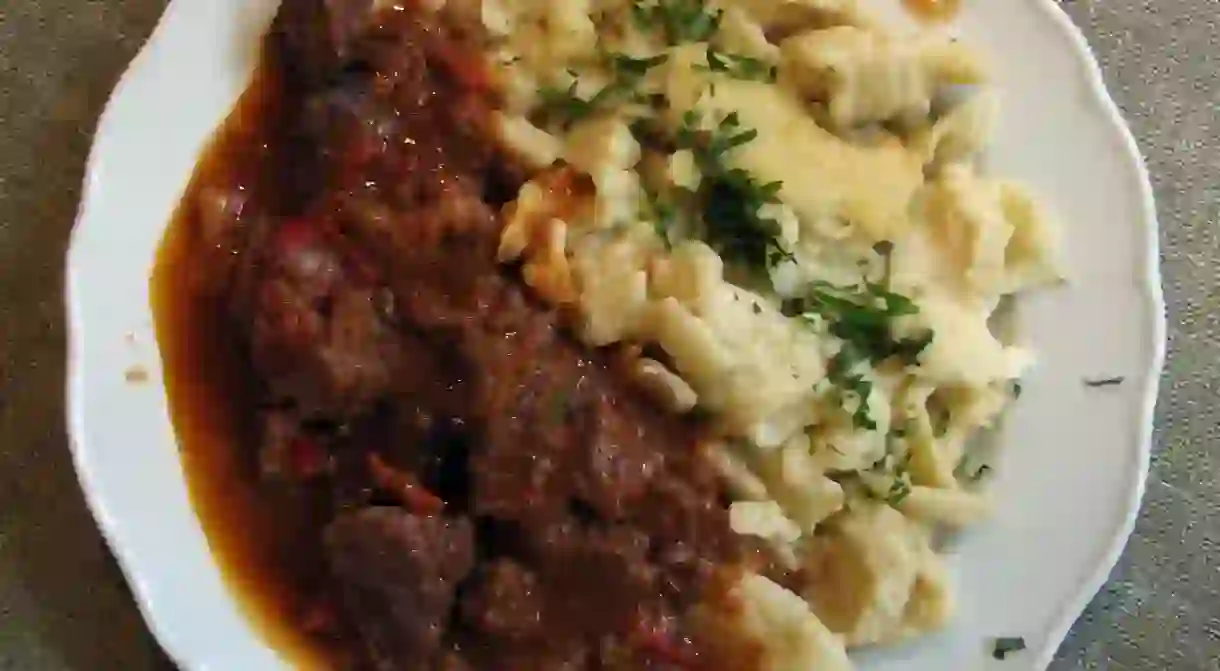What Do Hungarians Eat at Home?

While it’s easy to get lost in the showmanship of a country’s food, the promise of ‘typical local cuisine’ doesn’t always provide the truly authentic experiences that locals have at home. Hungary is no different and, while goulash is certainly a familiar national dish, the cuisine that most people enjoy is often simpler and easier to prepare. Here, we explore the meals that Hungarians actually eat…
Just got in from work…
A post shared by Csaba László (@ch4bi) on Jul 4, 2017 at 6:54am PDT
Túrós tészta
Pasta is the go-to just-need-to-eat-something food for practically every European country. Whether it’s strings or spirals, shells or farfalle (bow-ties), the ease of throwing pre-made dried Italian dough into boiling water and adding it to sauce knows no borders.
The difference is in all the extras; the flavours that change from country to country to fit the needs, tastes and available ingredients. For Hungarians, that’s túró, a crumbly cottage cheese that has a multitude of uses across the spectrum of Hungarian recipes.
Túró pasta (tészta in Hungarian) is an incredibly uncomplicated dish served with bacon bits and sour cream. Yet it is also completely customizable and is just as suitable as the jar of red sauce in the back of the fridge.

Palacsinta
Pancakes – or palacsinták in Hungarian – aren’t an unusual sight across Europe and happen to be one of the most diverse dishes throughout the continent. Hungarians also love the idea behind pancakes, but they are especially creative when it comes to making them.
Hortobágyi is a very popular dish, typically rolled like a burrito and stuffed with meat and onions and served with a generous creamy paprika sauce. However, hortobágyi is far too grand a dish for those who have had a long day in the office, so instead, most pancakes in Hungary are typically eaten with a side of fried bacon, pre-sliced ham or cheese. Some will even forgo the pretense of adulthood and skip the savoury dinner version and opt for a thick chocolate or vanilla palacsinta with a dusting of powdered sugar.

Paprikás
While the anglicised spelling of ‘paprikash’ might hint at a more intricate recipe, it does in fact refer simply to a sauce made with paprika – a favourite flavour among Hungarians.
This dish is normally made with roughly chopped chicken or beef pieces – sometimes even left on the bone – that are simmered in a spicy paprika sauce. Sour cream – or more specifically, tejföl which is the Magyar form of it – is typically added to soften the incredible heat of Hungarian paprika, as well as give the sauce a little viscosity.
Now traditionally this dish would be served with a healthy portion of small thumbnail-sized dumplings called nokedli, but this would be quite a bother to prepare in the evening, so it’s more commonly served alongside pasta or rice.
On the weekend…

Rakott krumpli
Literally meaning ‘layered potato’, rakott krumpli may not appeal to the uninitiated, but it is one of the most popular comfort foods in Hungry. What makes it even more unique is that each family has its own subtle twist on the basic recipe.
The recipe is simple: slices of parboiled potato are placed in a deep tray alongside Hungarian sausage (kolbász), hard-boiled eggs and onions. The mix is then covered in as much sour cream or tejföl as can fit. It’s starchy, wholesome and easily adaptable: some people like to swap sour cream for a white sauce, chicken instead of sausage and even use sweet potato.
There’s a whole family of ‘rakott’ dishes as well, though each recipe comes with its own unique twist. Rakott karfiol, for example, involves pouring a creamy cauliflower sauce atop a minced meat and rice mixture. Rakott káposzta uses cabbage leaves for a similar effect.
Libamáj szalonnában
Goose liver, or libamáj, doesn’t share the same love-it-or-loathe-it sensibility in Hungary as in other places, primarily because it’s cheap and commonly served up for dinners – even at a young age.
It’s most common form is wrapped in bacon and baked in the oven with garlic and onion; however, it is served with a number of other preferences. It’s commonly served alongside krumplipüré (mashed potatos) for a meal that feels gourmet, but absolutely isn’t.
Chicken liver often gets the same treatment, and while this isn’t exactly a typical Hungarian dish, it is something that is served up at least once a fortnight in most households.
A post shared by Betti (@fittlany) on Jan 10, 2018 at 6:50am PST
Főzelék
Once you’ve finished struggling with this word (feu-zeh-lake), you might find its meaning interesting; it loosely translates to ‘something made by cooking’. This is an overarching style of cuisine that is unique to Hungary, but its closest English equivalent is the long-forgotten soup/stew hybrid known as pottage. The primary ingredients in this dish are beans, peas or lentils, but it is just as commonly made with squash, spinach, tomatoes and other vegetables. A common recipe is babfőzelék (bean pottage), a thick stew cooked on the stove with a bit of flour to thicken it up.
Since it is commonly served alongside meats – typical favourites being Debrecen sausages and fried eggs – főzelék has an incredible range of options available to it.













